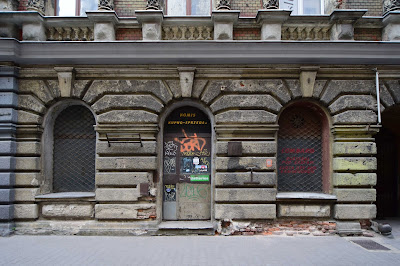Many of the factories and tenements went to rack and ruin. Suffering from massive unemployment in the 1990s, many people couldn't afford to pay the city rent for their flats, which consequently were not maintained. With the city owed hundreds of millions of zlotys in back rent, the authorities came up with a solution - to offer the non-payers alternative accommodation at the very edge of town that (just) fulfilled civilised norms; magically, the back rent started pouring in.
And there's investment - first, manufacturing - firms like Siemens-Bosch, Indesit, ABB, Dell Computers. Next, the business process outsourcing centres (India's Infosys, for example, employs 1,100 people doing business back-office activities for companies like Philips and Akzo-Nobel).
Łódź is a city of students. The city fathers understand the need to keep them from leaving the city on graduation, and have come up with some incentives. Among them is the Miasto Kamienic ('City of Tenements') programme. Wholesale renovation of the old buildings has been taking place for some while (progress is visible by looking at my posts from Łódź from March of this year, from 2012, 2011, 2009 and 2008.) By the way, do click on those posts to see pics of several remarkable refurbishment projects.
Even so, there's a vast amount still to do. Below: on ul. Jaracza. Note the green rabbit (made of moss), one of several moss artworks growing on the side of Łódź tenements.
This tenement (below) reminds me of the cover of Led Zeppelin's Physical Graffiti album. The nets are presumably to protect passers-by from falling stucco or masonry.
Below: closer up look at the texture of Łódź reality. This is a city that unlike Warsaw, Gdańsk, Poznań or Wrocław, was spared much bombardment and street-fighting. The crumbling buildings are not pock-marked by bullets or shrapnel.
Below: emerging from under layers of flaking paintwork, a pre-war shop sign. This one is by what was a Colonial Products shop. The concept of 'Sklep Kolonijni' came from Germany (kolonialwarenladen), which did have overseas colonies in Africa. Colonial shops sold tea, coffee, rice and other exotic groceries from distant parts. Communist Poland did not approve of colonialism. Takie kolonie, takie sklepy, said Poles of the newly-emptied shops.
Below: Łódź is a city of street art. Across ul. Sienkiewicza from the PRL-era ad for Pewex ('the State Internal Export Enterprise') is a 2014 work by Brazilian artist Eduardo Kobra, a homage to local boy Artur Rubinstein, one of the greatest classical pianists of the 20th Century.
Behold, how Łódź can look once the buildings have been refurbished (below). The role of the city authority's heritage building conservator is crucial; windows must be wooden, fittings in keeping with the period, paintwork as far as possible matching the original.
Private and public funds are coming together to lift Łódź out of the mire; if it all comes right, this could be a magnificent, creative city. Below: a podwórko (courtyard) being brought back to life.
Below: a quality restoration job. One day, this will be Łódź's Knightsbridge, full of mansions.
Below: a hole in the ground, so deep and sort of round it was... From the top of the Textilimpex building (entrance free) you can see the work going on around the major redevelopment of Łódź Fabryczna station, which closed to trains in October 2011. As usual, work is massively delayed (I can't see the new deadline of this September being met). The concept was to knock down the old station and rip up the tracks leading into to the centre of Łódz, and build a tunnel under the town linking this line with the line running along the city's western edge (where Łódź Kaliska station runs).
Work to turn Łódź into a modern city on the base of an old industrial one, ending decades of decline into shabbiness, continues. It's more than about the money - it's about people's faith that the place is moving on the right trajectory. Coming here over the years since the late 1990s, I'm convinced that Łódź has reached a critical point in its development, and that things will start improving at a faster rate. The completion of the station and the surrounding EC1 project (that's EC as in elektrociepłownia or 'combined heat and power plant' rather that East Central One, though the areas is east-central) will be crucial.
Given that flats are less than half-price compared to Warsaw, and that unemployment is now half of what it was in the bad old days (though still double Warsaw's), my bet is on prime Łódź real estate as something to buy and hold.
This time last year:
Liverpool reborn
This time This time last year:
What goes round comes around: retro is cool - again.
This time three years ago:
Warsaw's southern bypass by this time next year?
[No, it was September 2013]
This time four years ago:
Stand Easy! - a short story
This time seven years ago:
God Save The Queen - I mean it, Ma'am
















4 comments:
I seem to recall that in the UK there was a chain of food shops called Home and Colonial. I may of course be wrong.
And who remembers that BHS was British Home Stores!!
... And Army & Navy, Derry & Toms, Barkers... and closer to home in Ealing, John Sanders, Daniels and Rowse's. Gosh - how the face of British retail has changed... "Sketchley and Unigate, Dolcis and Walpamur" to quote John Betjeman (from Metro-Land, the bit about Neasden - "home of the gnome and average citizen")
If properties in Lodz are to be a good investment, do you imply demographics will work in favour of the property market, i.e. the trend of Lodz depopulating is about to reverse?
@ student SGH
No reversing, the demographic mix is changing. Fewer people all told, but the Henieks and Ziuteks are being replaced with computer-game programmers, DJs, textile designers and film-makers.
Post a Comment